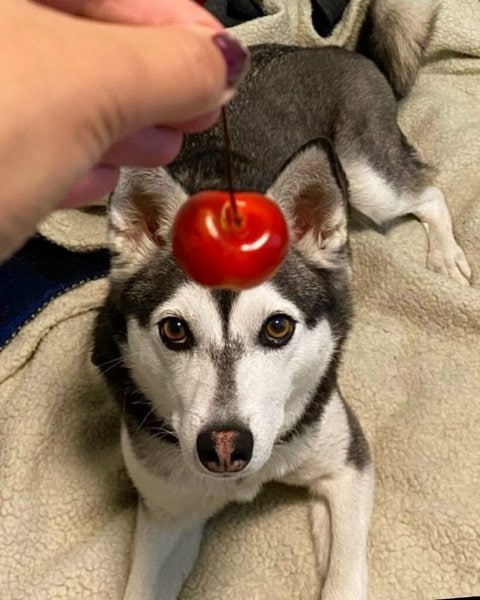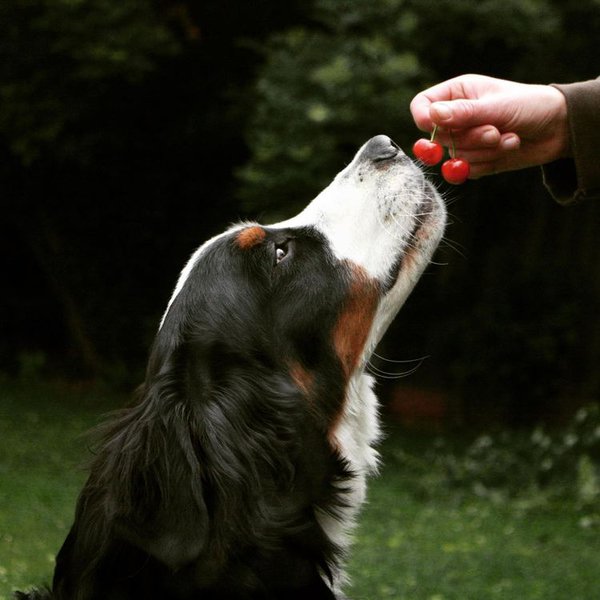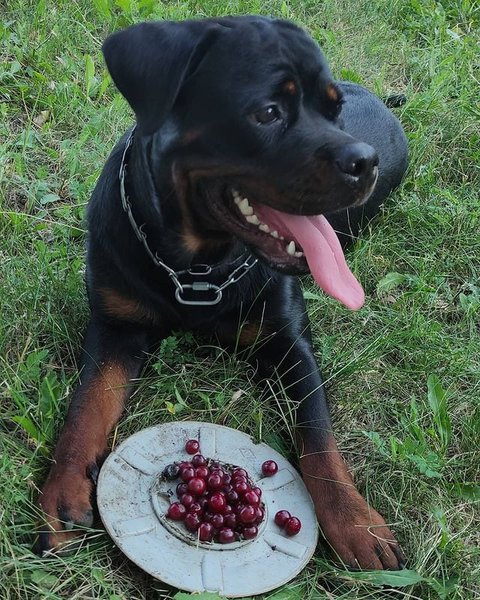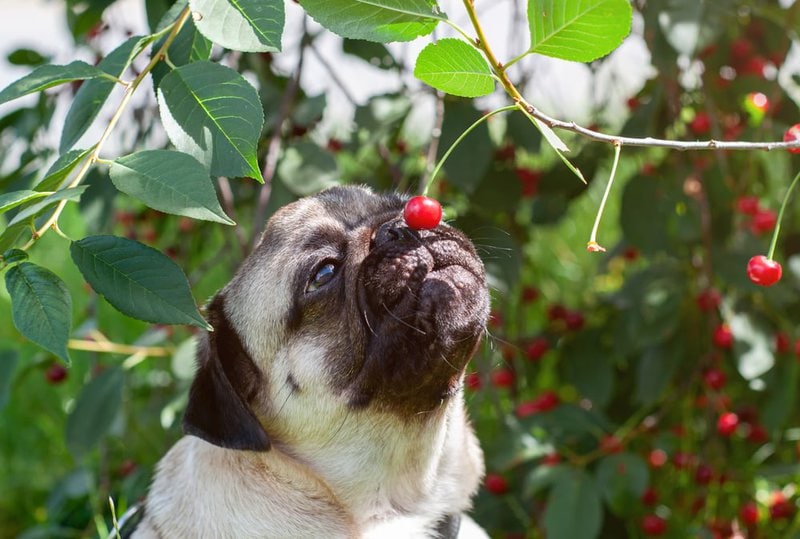One constant question on every dog parent’s mind is whether or not they can share a sumptuous dish or fruit with their beloved four-legged companions. And, when it comes to fruits, there’s a question that boggles even stronger: can dogs eat cherries?
Dogs should not eat cherries as a whole, but they can eat cherries without the pits and stem. The important reason behind removing cherry pits is because they contain cyanide that causes fatal poisoning when consumed in large amounts.
Cherries aren’t altogether bad for dogs. Researchers have even found that cherries contain vitamin C, which helps boost a dog’s immune system, and vitamin A, an excellent substance that grants clear vision. But, more importantly, cherries contain dietary fiber that increases digestion in a dog’s system.
Nevertheless, despite the many nutritional benefits packed into this red succulent fruit, it isn’t compatible with a dog’s digestive system. Humans and cherries? Yes. Dogs and cherries? No. Hence, as a dog parent, it behooves you to know everything about cherries and how they concern your dog’s health.
And the purpose of this guide is to let you know: why cherries are harmful if a dog can eat pitted cherries, what to do if a dog eats cherries, the recovery time of dogs with cherry poisoning, and more.
Why Are Cherries Harmful to Dogs?

Cherries harm dogs for many reasons. Your beloved canine could go from munching on cherry pits to gnawing on the leaves and stems. And like the stones, cherry stalks and leaves contain cyanide potent enough to cause fatality in an animal.
Here are some of the significant factors why they aren’t safe for your dog:
Intestinal Blockage
Cherry pits – the hard outer shell covering of cherry seeds – are tough to digest. And given that there are lots of pits in a single cherry, it’s easy to see how these hard substances can block your furry pal’s intestines. What’s worse, the intestinal blockage could lead to severe pain, which, if not treated, results in death.
A dog suffering from the painful symptoms of intestinal blockage can find relief through one process only – surgery. The cost of surgery combined with the physical torture your canine friend would pass through isn’t worth the fleeting satisfaction that comes from feeding your dog cherries.
Esophageal Ulcer
An esophageal ulcer occurs when the rough, jagged exterior of a seed grates against the esophageal canal of a dog, causing pains there.
Sometimes, the friction in the esophagus could be so much that it tears the walls of the throat. Tears then create an opening for bacteria which leads to infections.
Sadly, despite receiving treatment for an infected esophagus, the esophagus might lose the ability to stretch like before, which could make swallowing torturous for your pooch.
Another phenomenon that often happens aside from esophageal ulcers is the total blockage of the esophagus canal. This occurs when pits and stems lodge in your dog’s throat, thereby preventing airflow to and from the lungs.
An esophageal blockage bears similarity to a choking hazard, and choking hazards could spell death for dogs in a matter of minutes.
Cyanide Poisoning
Cyanide is a highly poisonous substance that causes death within seconds when ingested. Inside every cherry stone, there’s some quantity of cyanide that could lead to a disastrous outcome when chewed.
Note that when swallowed whole, cherry pits can’t cause cyanide poisoning. Instead, cyanide toxicity occurs when your pooch chews through the hard cherry stone, hence releasing the toxic content within.
And since dogs are prone to do battle with their teeth, there’s always a high likelihood that a dog that happens on a cherry fruit will, more often than not, gnaw on the tough cherry stone exterior after eating up the fruit’s succulent flesh.
Below are the signs of cyanide poisoning:
- Bright red gums
- Labored breathing
- Convulsions
- Dilated pupils
- Teeth fracture
The outer shell of a cherry stone is so hard, some folks who intend to plant the seeds break it using a hammer.
Imagine your dog with its innate instinct to chew and crack things open, biting down on a hard cherry pit and accidentally chipping a tooth. What’s worse, a chipped tooth could damage a nerve ending in the pulp, causing severe pains and swollen gums.
Furthermore, if the chip extends to the crown – the part of the tooth that sits in the gum, then there’s going to be a need for tooth surgery which could be mentally and financially taxing.
Intoxication
If you leave fresh wine for a while, it starts to ferment. The same applies to cherries that have been left to rot that later end up in your dog’s stomach.
Consequently, ethanoic acid in the fruit bonds with the hemoglobin in the blood and depletes the oxygen there. The depleted oxygen in the hemoglobin starves the brain of the energy it needs and causes partial brain shutdown, which leads to intoxication.
Incidentally, intoxication among dogs is peculiar to dog parents who own cherry orchards. Although dog owners who accidentally feed rotting cherries may not have an intoxicated dog on their hands often, it does happen occasionally, and the result is more often than not disastrous.
What To Do If My Dog Eats Cherries?

Depending on the manner of ingestion, either of two things could happen: Cyanide poisoning could set in if your dog chewed lots of cherry pits, or gut blockage could occur if the cherries were swallowed whole.
Cherry poisoning from cyanide needs to be treated immediately to forestall further spread of the poisoning. The best way to reduce the effect of cyanide is to introduce a neutralizing substance that dissolves the cyanic compound.
Your veterinarian is in the best position to assist your dog at such a life-threatening moment.
Concerning intestinal blockage, once you discover your dog exhibiting symptoms such as vomiting and swollen abdomen, the next step is almost always surgery. However, if the obstruction is in your furry friend’s esophagus, you could lower its jaw and try to extract the pit if you can.
It’s imperative that you avoid practicing online home remedies on your dog. Since your pooch is already going through much pain, applying methods that haven’t been tested could worsen its suffering.
How Long Does It Take A Dog to Recover From Cherry Poisoning?
Recovery from cherry poisoning is a gradual process that depends on several factors.
First, the extent of the health damage your dear Fido suffered before receiving treatment determines how long the recovery process would take.
Furthermore, the age of your pooch determines the speed of recovery, too. For instance, large dog breeds like Rottweilers or Bull Mastiffs can recover quickly from cherry poisoning compared to their smaller counterparts.
Second, the selection of the medical treatment method to perform on your dog influences the recovering time. For example, a surgical procedure on your dog will take a longer healing time than a cyanide detoxification procedure that requires IV fluids and other intravenous medications.
Lastly, the level of care and attention your dog receives post-surgery/treatment determines the duration it would take to recover. Additionally, you need to make sure you agree to meet the vet with your pooch at the appointed time, so your canine pal’s health doesn’t deteriorate.
Can a Dog Eat Pitted Cherries?
Yes, a dog can eat pitted cherries. However, moderation is critical. Dog parents could sometimes overindulge their pooches when feeding fruits like cherries because, to them, the dangerous seeds and stems are no longer in the equation.
In addition, try to ensure the freshness of the cherry’s flesh before giving your dog to eat. That’s because mold growing inside cherries can cause illnesses for your dog.

How Do I Pit Cherries For My Dog?
If your furry pal has grown to love cherries as a treat, there are two ways to pit cherries and guarantee safer enjoyment for your dog.
The easiest and fastest way is to use a cherry pitter. And you do so by taking out the cherry’s stem, setting it at the mouth of the pitter, and pressing the handle so that the pit shoots out of the flesh.
The other method is as simple as using a paper clip to dig out the pit from the cherry.
As you feed your dog the cherry flesh, always remember to apply moderation because too much cherry, even without the stones, can be terrible for dogs.
Can a Dog Eat Other Cherry Types?
There are several types of cherries: Wild cherry, chokecherry, black cherry, cherry laurel, domestic cherry, and the likes. Unfortunately, many harbor cyanide within the pits, so you don’t want your four-legged buddy near any.
Now, maraschino cherries are special cherries that don’t have stones and stems like others. That said, maraschino cherries undergo a bleaching process that rids the cherries of beneficial nutrients.
Even worse is the fact that these cherries are often dunked in syrup and sugar such that they become so sweet, their initial calorie content triples right after the bleaching procedure is completed.






